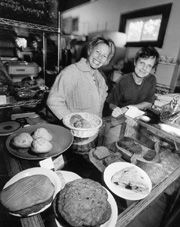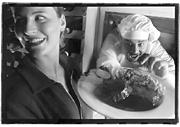A whole lot of a particular genre of book has been landing on my desk lately. Three are stacked there now: A Woman’s Path, Women in Love, and Generations of Women. Here is what I see when I page through Generations of Women: full-page black-and-white portraits of great-grandmothers and grandmothers and daughters and their daughters, alongside in-their-own-words blurbs about their family relationships. The price tag reads $27.50. The other aforementioned books, whose photographs and blurbs respectively chronicle women’s career paths and lesbian families, are priced more or less the same, up to $30.
As I wander down A Woman’s Path, browsing through the lush photos and essays, I encounter passages like this: “Being a designer is not so much what I do as who I am.” And this: “People need to be encouraged to follow their dreams.” The weight of all this earnest rumination, focused entirely on the self, rings by turns banal and self-indulgent. Before long an insistent question begins to form in my mind: Who is buying these books?
A Woman’s Path
by Jo Giese, photographs by Jill Johnson (Golden Books, $30)
Generations of Women
photographs by Mariana Cook, introduc- tion by Jamaica Kincaid (Chronicle Books, $27.50)
Women in Love
photographs and interviews by Barbara Seyda with Diana Herrera (Bulfinch Press, $29.95)
“Women,” declares Karen McDermott, publicity director at Golden Books, without missing a beat. “Women tend to buy the self-help books and books about family.” Women, increasingly, buy most of the books in general—up to 85 percent, by some estimates—which may explain why this woman-specific genre is so hot these days.
It’s hot this month, of course, because of Mother’s Day. “These are books people buy to give as gifts, and graduation and Mother’s Day are probably the two biggest occasions for them,” explains McDermott. No fools, publishers time their releases of these glossies to the Mother’s Day season to attract press coverage. But booksellers report that the relationship picture book is a seasonless seller. “These sell all year ’round as gifts—Christmas, birthdays, whenever,” says Elliott Bay Book Co. buyer Rick Simonson. “In a place like Seattle, you’re talking about a lot of adults who don’t live near their families. Books like these can convey a little more than a card about the relationship, without being too deep.”
And without pushing the envelope, apparently, of what gift givers are willing to pay. Publishers reveal that they try not to exceed $30, the line in the sand past which a Mother’s Day acknowledgement begins feeling a little more like an investment. “With Sisters I think everyone found out just how big the market was for this kind of family relationship picture book,” muses McDermott. “And how much people were willing to spend.”
Sooner or later any talk about these volumes turns to Sisters, the stunning 1994 best seller from a small Philadelphia house, Running Press, known mostly for its children’s and how-to books. There had long been coffee-table books—the breathtaking meaninglessness of which was dead-on lampooned when Seinfeld’s Kramer pitched his famous coffee-table book on coffee-tables—and the early ’90s saw publication of a few significant portrait essay books, like Gifts of Age (photos of aging people) and I Dream a World (portraits of black women).
But no one, not even Running Press itself, was prepared for the phenomenon of Sisters, the volume of glossy sister portraits sporting supermodel Christy Turlington and her siblings on the cover. Running Press’ associate publisher Brian Perrin reports that the house merely expected to sell up to its respectable 20,000-copy first printing. It blew through that within the first six months. “We had no books left in the stores that first Christmas,” Perrin recalls. Soon after hustling Sisters back onto bookstore shelves, Oprah Winfrey featured the book on one of her programs. “We’ve now sold,” Perrin reports, “just over a million.”
Applying publishing rule no. 1, that no success shall go uncopied, other houses immediately began weighing in with their versions: portrait compendiums of mothers and daughters, mothers and sons, fathers and daughters, fathers and sons, gay couples, young African American men, and on and on. “I’m loathe to use the word ‘formula,’ but… ” observes Chronicle Books publicity assistant Steve Moore. The danger, Simonson warns, is oversaturation of the category. Robert Bly’s Iron John, Simonson recalls, inspired a flurry of men’s movement genre copycats and most of them, including the good ones, were trampled in the stampede.
But that may not be the case here. Publishers believe that the relationship picture book genre is perfectly keyed to the pitch of the times. “The timing is right: People want to reconnect with family and community,” observes Julie Chanter, marketing director at Chronicle Books. The recent spate of women-reflecting-on-relationships books—the Girlfriends series by Carmen Renee Berry and Tamara Traeder, NPR commentator Cokie Roberts’ We Are Our Mothers’ Daughters—would bear this out. “The popularity of books like Generations of Women is not a Mother’s Day phenomenon,” declares Chanter. “It’s not about a gift for mom or sis—it’s a much bigger issue of reaching out for community.”
Critical to this end is the books’ first-person narratives, an aspect Running Press’ Brian Perrin has reflected on all the way to the bank. “The sharing of people’s stories is key to the success of these books,” he reports. “As our modern lifestyle has expanded and become more frenetic, and the world has grown smaller and our horizons hugely bigger, there’s been a loss of the sort of storytelling, the sharing of anecdotal wisdom, that used to happen in small towns. Where you sat on your front porch at night and caught up with one another’s families.”
Is that the appeal of these books, then—the human animal’s desire to feel a sense of belonging to a group larger than oneself? For my part, the more I began ruffling the pages of the picture books on my desk, the more I kept wanting to—almost in spite of myself. The vignettes go down like potato chips; I couldn’t read just one. Brian Perrin has a theory. “With every [photo-essay book] we publish we get dozens and dozens of letters from readers who say, ‘These stories really touched me, I’d love to be included in your next collection,'” he says. “I think one of the most important connections people feel from these books is the immediate one: This could be me.”







